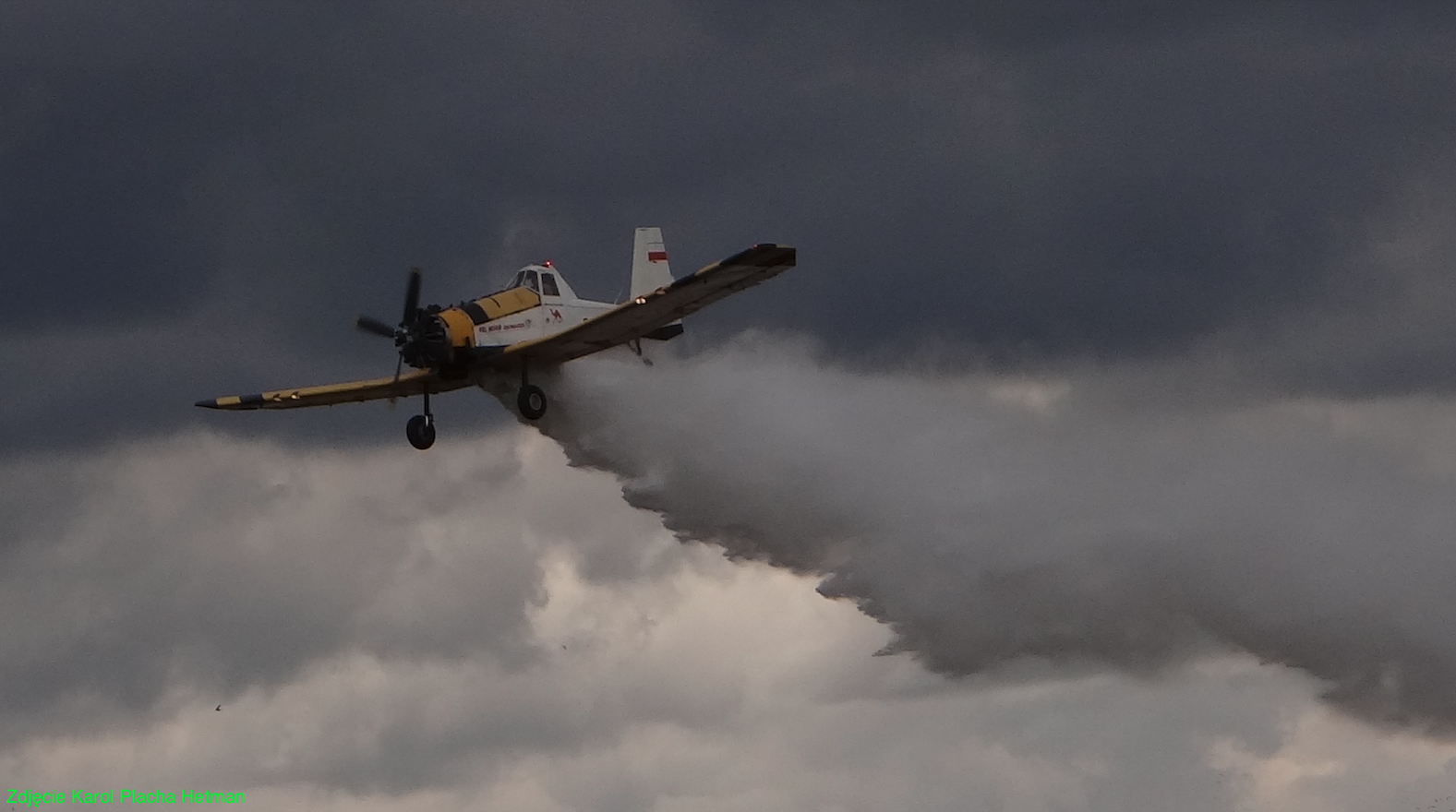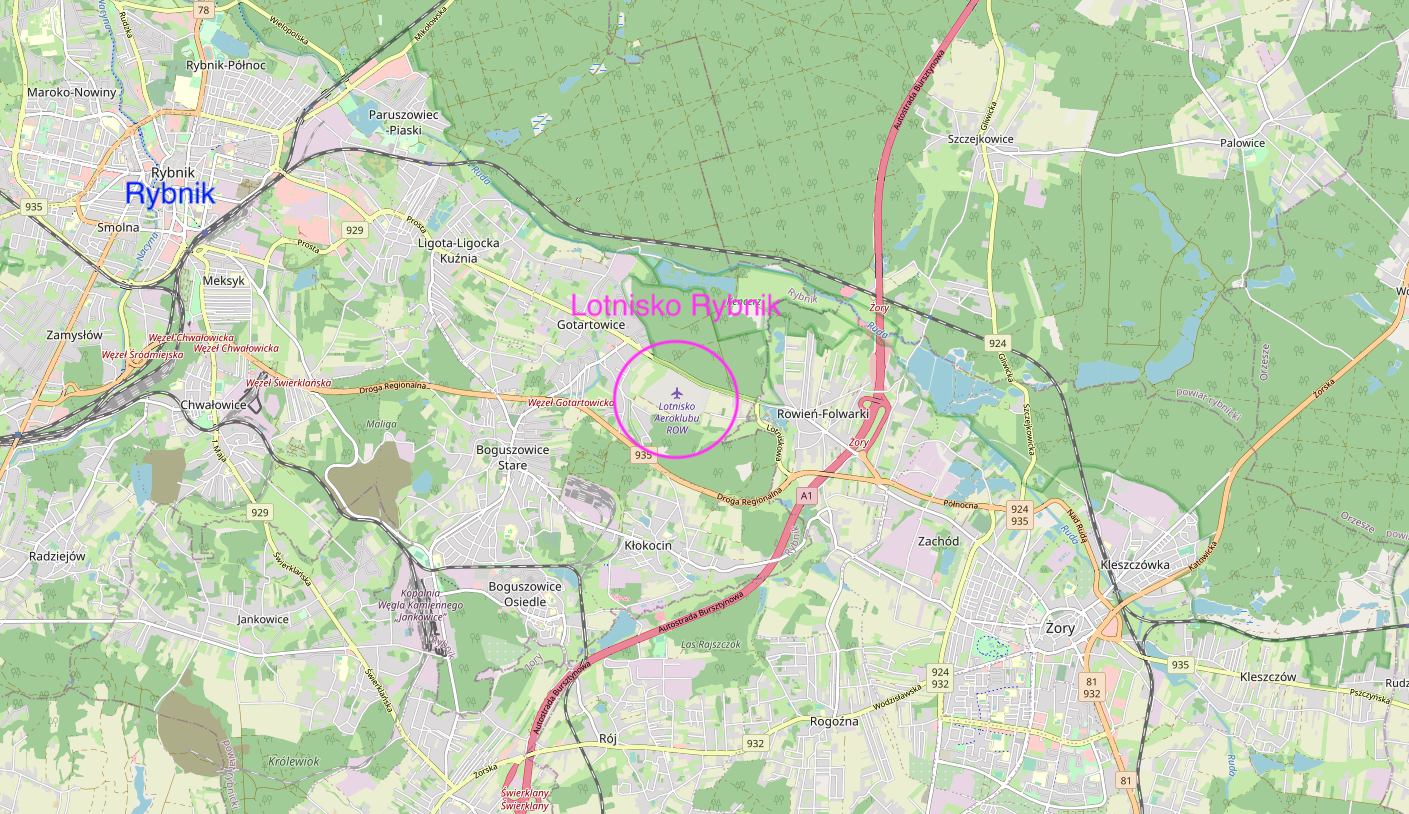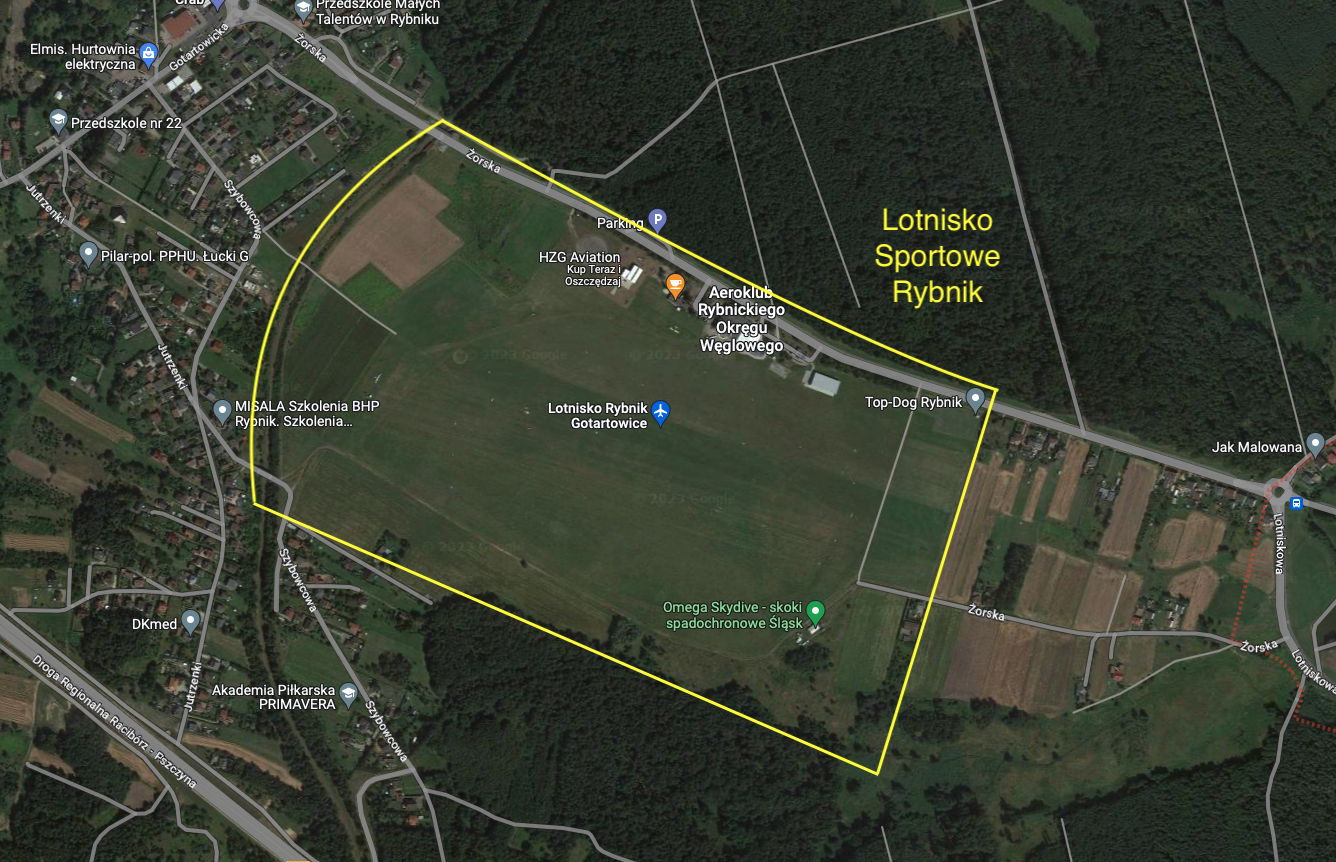Rybnik 2023-02-15
Rybnik Gotartowice airport.
Geographic coordinates: 50.071N 18.628E. Elevation 255 m.
The city of Rybnik.
Rybnik is a city in Poland, located in the Silesian Voivodeship. Historically, it lies in Upper Silesia. The development of the mining industry has brought the city’s population to 132,923 (2021).
Rybnik is located on the Rybnik Plateau, which is part of the Silesian Upland, in Upper Silesia. The distance from Rybnik is to: Gliwice – 25 km. Katowice – 45 km. Krakow – 115 km. Wroclaw – 170 km. Warsaw – 325 km.
The name of the city of Rybnik appeared in a document issued in Berlin in 1750, which was issued in Polish. The name Rybnik comes from the Polish name meaning a pond intended for fish farming. In Silesian and Czech, the word rybnik also means a fish pond. The village was first mentioned in a Latin document of Pope Gregory IX issued on May 26, 1230.
In the place of today’s Rybnik, a settlement existed already in 1592, which is shown on the map of Wacław Grodziecki. There were many fish ponds in the vicinity, from which the city got its name. Christianity reached the area in the 10th century. In the 12th century, there was already a parish of the Blessed Virgin Mary here. The founder of the church was Mieszko I Spindleshanks, Duke of Racibórz. In the 13th century, there was an order of Norbertine Sisters here. Until the mid-fourteenth century, Rybnik was under the rule of the Silesian Piasts. In the city center, a medieval Piast castle has been preserved, which currently (2023) houses a district court. In its history, Rybnik was destroyed several times; by wars, fires and plagues. In the 16th century, Rybnik gained the right of fairs, the so-called market privilege. In 1607, Rybnik became a private town, becoming the property first of the Czech Lobkowic family, and from 1682, of the Polish Hungarian family. As a result of the wars conducted in the 18th century, Rybnik was annexed to the Kingdom of Prussia. In 1788, Antoni Węgierski sold the town to the Prussian king. The development of industry (mainly mining and brewing) and the introduction of railway lines to Rybnik in 1856 contributed to the increase in the number of inhabitants. It was a time when most of the inhabitants still spoke Polish. The influx of miners from the Sudetenland changed this attitude at the end of the 19th century, when most of the population spoke German. On March 20, 1921, a plebiscite was held in Upper Silesia. In the city of Rybnik, the vast majority (71%, otherwise 4,714) voted for Germania, while in the Rybnik poviat, 65%, otherwise 52,347 valid votes were cast for joining Poland. Because the Germans did not respect the results of the plebiscite, the Third Silesian Uprising broke out. On July 3, 1922, on the Rybnik market square in front of the old town hall, two important documents were signed: an act formally ending the takeover of the part of Upper Silesia granted to Poland, and a protocol regarding the transfer of Rybnik and the Rybnik poviat to the Polish authorities. The next day, the Polish Army entered Rybnik – the 3rd Podhale Rifle Regiment. Thanks to good management, the town was able to develop, the number of inhabitants increased, and the county office was located in the town. In the interwar years, a new building of the City Hall, schools, new roads were built, squares were established and the market square was renovated. The further development of the city was interrupted by the attack of the German army. Stupid Germans, together with their Muscovite brothers, started another world war and lost Upper and Lower Silesia.A few remarks here. We, the Poles, did not set the borders after World War II. We, the Poles, did not drive the indigenous people from their homes and land. We, the Poles, did not start this cruel war. The Germans have a grudge against themselves. We, the Poles, are the greatest victims of World War II and have lost the most.
The Soviets entered Rybnik on March 26, 1945. The city was returned to Polish hands. Thanks to the development of heavy industry (mining, metallurgy and energy), the city developed rapidly. The Rybnik power plant is one of the largest plants of this type in Poland. In the 1970s, Rybnik expanded by incorporating the surrounding towns. In recent years, the city authorities of Rybnik have done a lot to improve the natural and climatic conditions in the city. Many parks, green areas and squares were established. Many natural places have been preserved.
Rybnik is very well connected with the rest of Poland. The Rybnik bypass was built in 2013. The following national and provincial roads run through Rybnik: A1 motorway (Gdańsk – Rybnik – Gorzyczki). National road No. 78 (Chałupki – Wodzisław Śląski – Rybnik – Gliwice – Zawiercie – Chmielnik). Provincial road No. 920 (Rudy – Rybnik). Provincial road No. 925 (Rybnik – Orzesze – Ruda Śląska – Bytom). Provincial road No. 929 (Rybnik – Świerklany). Provincial road No. 935 (Racibórz – Rydułtowy – Rybnik – Żory – Pszczyna).
Rybnik – Gotartowice airport.
Geographic coordinates: 50.071N 189.628E. Elevation 255 m (836.6 ft). Rybnik airport is a sports airport, it has the ICAO code – EPRG.
The first airport in Rybnik was organized in 1927, on the initiative of the Aviation Circle, and then operating as part of the Aviation and Anti-Gas Defense League. The Air and Anti-Gas Defense League (LOPP) was a mass Polish paramilitary organization established in 1928 as a result of the merger of the State Air Defense League founded in 1923 and the Anti-gas Defense Society founded in 1922. The league was intended to promote sport, communication and military aviation. The organization operated until the outbreak of World War II in 1939.
In 1928, the first hangar was built and the first “Kocynder” glider was purchased. Flight training started. The war and the period of occupation interrupted the commenced aviation activity.
In 1946, aviation activity was reactivated under the leadership of the Aviation League. Only the modeling section was functioning.
In 1959, the Social Organizing Committee of the Flying Club was established. Hard coal mines and their directorates provided significant assistance.
The airport was launched in 1963 as the airport of the Polish People’s Republic Aeroclub. The airport was built on land made available by the "Jankowice" Hard Coal Mine. Miners from nearby mines and soldiers from the National Territorial Defense Military Unit from Jarocin worked on the construction of the airport. Until now (2023), this unit specializes in the construction of field airfields for the Polish Army. In 1969, the airport was entered into the records of the Civil Aviation Authority. Currently, the airport is managed by Aeroclub ROW (Aeroclub of the Rybnik Coal District). The airport has a ground take-off field – grass. In 1964, the first hangar was built at the airport. In 1990, filling stations were built. In 2014, the first aviation picnic "Aero Club Days" was organized at the airport.
Firefighting aviation. In the period from early spring to late autumn, the Forest Air Base of the Regional Directorate of State Forests in Katowice is stationed at the airport. It returned to the airport in Rybnik in 1992, after a break of several years as a result of the analysis of the threat after the forest fire near Kuźnia Raciborska in 1992. Two PZL M18 Dromader aircraft are regularly stationed.
There are two RWYs at the airport. The first RWY with dimensions of 600 m x 100 m, in the direction of 090/270. The second RWY with dimensions of 590 m x 100 m, in the direction of 120/300.
Written by Karol Placha Hetman




